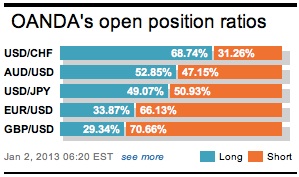Did we really believe that something ‘positive’ was not going to happen? Again US policy makers have come very close to potentially pushing the global economy towards another recession with their fiscal spats and political voting antics. In the end, they only have themselves to blame for ruining their ringing in of a peaceful 2013. As of early this morning, both the US Senate and the House of Representatives have finally agreed a deal to sidestep, for now, the full onslaught of the US “fiscal-cliff” where automatic year end tax hikes and spending cuts were to automatically kick in.
The bill, that is expected to be hastily signed and backdated, will raise the tax-rate on annual incomes above $450k (affecting most of the House and Senate personally) and makes the Bush-era tax cuts for lower income families permanent, for now anyhow. It also extends a variety of business and personal tax credits and postpones for two-months some across the board spending cuts.
Whoopee! This is what the market was waiting for, a sign, a compromise, the green light, and we got it or have we? It seems that the initial reaction of investors is to trade with relief, which is not the usual true sense of euphoric abandonment. Waiting on a positive compromise vote has dominated all asset classes and more so ever since Obama’s presidential election win in November. Global markets had been hoping that the US would not push itself and them into another recession. Today’s vote vindicates that, for the short term at least.

Is the US House and Senate decision just another ‘can kicking down the road’ exercise?
The win: the deal avoids the immediate fallout and pain of the fiscal cliff. The loss: because the deal does not include raising the US debt ceiling or the implementation of longer term budget cuts, we the investor, will be witnessing another US political showdown in the coming weeks as both aforementioned issues need to be negotiated. This will need to be completed next month or in early March to at least avoid a US technical default. The result: US Political uncertainty is expected to remain the dominant trading theme over the coming weeks, basically changing nothing from the last two months, apart from giving ‘the’ investor some ‘hope’!
The market should not get too hung up with US Political shenanigans for ‘sole’ direction. Also helping market tone this morning, for the short term at least, was Chinese and UK manufacturing activity. China’s official manufacturing PMI for December (released New Year’s eve) was unchanged from November’s print of 50.6. This technically indicates that the country’s manufacturing activity was up modestly from the previous month. The market can breathe a sigh of relief that things are not going backwards in that region, just yet at least!
Not to be outdone, in the UK there was some good news with their December’s manufacturing survey. It came in at a 15-month high of 51.4, and followed a positive revised reading to 49.2 in November. The bulk of the strength was in the output and new order index. This would suggest that next month could deliver another positive surprise. The skeptics will note that the strong reading only partially recoups some of the October and November loss, and calls into question the durability of the strength. Maybe the US could complete the trifecta? Some analysts expect this morning’s US ISM manufacturing PMI to recover above 50 after dipping below that key threshold in November (50.3).

Despite the upbeat tone, many market participants remain skeptical about the longer-term global picture. Today is technically the first trading day of the New Year and forex markets liquidity remains thin. The EUR or ‘single units’ late retracement early North American open seems to be only natural given that the move to breach the psychological 1.33 handle in Asia was “large and rapid.” Technically, the market is required to fill in the “gap,” and this is what we seem to be experiencing after the mini-agreement.
Now that the EUR shorts have been stopped around the 1.3285 mark in Asia where do we go from here? It’s basically more of a “wait and see” game. This is not the time to be too aggressive. The intraday studies have somewhat rebounded and seem to be undergoing a positive cross. The Techies would translate that as a potential “buy” signal. Upward momentum does lend support to buying the single unit on pullbacks; however, thin markets coupled with some investors focusing intently on that US ‘Can’ could argue selling risk soon. Patience is to be applauded.

Other Links:
USD/CAD Canadian Dollar 2012 Wrap up
This article is for general information purposes only. It is not investment advice or a solution to buy or sell securities. Opinions are the authors; not necessarily that of OANDA Corporation or any of its affiliates, subsidiaries, officers or directors. Leveraged trading is high risk and not suitable for all. You could lose all of your deposited funds.


